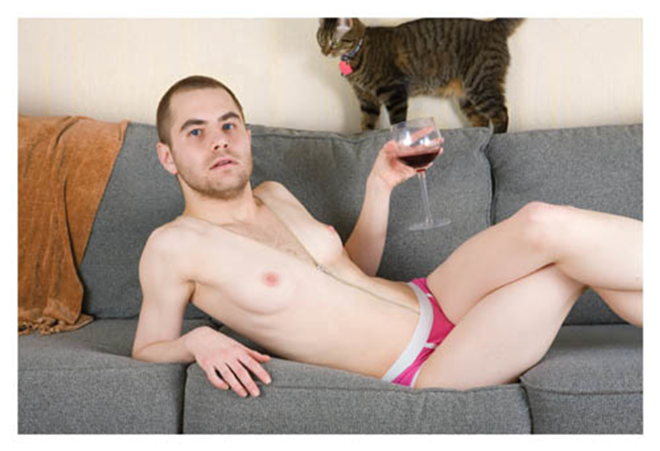
This summer, bubble wrap lines the windows of Mindy Solomon Gallery on Beach Drive — a measure of caution occasioned by the somewhat outré exploration of feminine experience housed inside. In its most coquettish form, the exhibit looks like Sean Fader's I want to put you on, Raini. The digitally crafted composite photograph displays Fader's head atop a lithe, semi-nude female body, which the (male) artist appears to wear as a skin-tight suit that zips up to his neck. Languidly reclining on a sofa, the gender-bending creature's pink nipples wink at the viewer while he-she hoists a glass of wine.
Cheers, indeed — to my thinking. But then, if gender gymnastics and vaginas dentata freak you out or piss you off, Solomon's exhibition won't be your cup of tea. Hence the bubble wrap.
In Undressing the Feminine, as the show is called, eight artists from near and far, working in photographic and ceramic media, engage ideas and iconography associated with female experience. While that genteel title suggests a mildly titillating unveiling of the feminine's closely guarded truths, what the artists on tap provide is a combination caress and shattering, a perversely loving deconstruction and inversion that leaves viewers wondering just what the hell "the feminine" is rather than celebrating its revelation or stability. Let's get the shock treatment out of the way. On two walls, Becky Flanders' large-scale photographs show a standing, masked woman issuing a stream of piss from between her legs. Throughout the gallery, Anne Drew Potter's sculptures of nude female forms combine adult and infantile expressions and gestures to creepy effect. J. Aiden Simon's digitally altered photographs provide fictitious documentation of the artist's real gender transition from female to male. And Bonnie Seeman's bulbous ceramic vessels — the most innocuous inclusion in the exhibition, at first glance — bear vaginal crevices filled with miniature glass teeth.
If you haven't yet thrown down this newspaper (or clicked away from this webpage) in disgust, you're in for a treat — because the works I've described are far from mere plays for scandalized attention. Perhaps even more than the other exhibitions she has hosted during her first 10 months in business, Undressing the Feminine gives a sense of how Solomon sees her role as a gallerist in Tampa Bay. Playful, perverse, smart, and full of affordable work by emerging and established artists, here's a show that would easily feel at home at a sophisticated nonprofit — or, speaking frankly, in a market more saturated with adventurous, urbane collectors. Perhaps not surprisingly given her track record as a supporter of and curator for local nonprofits (Dunedin Fine Arts Center, Florida Craftsmen, Morean Arts Center), as an arts educator, and as a formidable collector in her own right, Solomon offers (again and again) exhibitions with equal parts intellectual bite and commercial appeal. That she doesn't seem to have gotten the memo that playing it safe is the best way to run a gallery in the Bay area fills me with elation and concern.
Let's stick with elation for now. There's a palpable sense of it in Sean Fader's portraits, like the perky-nippled sylph who anchors the show — an Olympia for the Photoshop-savvy genderfuck set. Fader, who lives in Brooklyn, arranges the shoots by requesting sittings with people — sometimes women, sometimes men — whose lives he covets for whatever reason (e.g., they're hot). After making a nude or semi-nude portrait of the model — let's say it's a woman — Fader takes her place in front of the lens, asking the model to photograph him in a pose or with an expression that the model feels captures her identity. Afterwards, Fader digitally melds his head to the other's body with a zipper seam (literally) that creates the illusion that the artist is wearing his model like a second skin. Hilarious and disturbing, the images trace a hall-of-mirrors of performances — me pretending to be you; you pretending to be my image of you — that precipitates kernels of wisdom about identity and relationships, even with tongue firmly in cheek.
Confession: I never thought twice about contemporary ceramic sculpture before Solomon went public with her passion for the medium. Now, like any true evangelist, she's making converts — myself included — with her gallery. Bonnie Seeman's ceramic vessels are some of my favorite pieces in this show; plump like ripe, peachy fruit, they exhibit crevasses filled with lampworked glass thorns, critters and flora — a spider here, a cluster of miniature lilies there — that invite intimate contemplation. That the prickly voids scream vagina dentata adds a deliciously naughty cast to the vessels' visual seduction.
On the figurative front, Anne Drew Potter's ceramic sculptures of female bodies inspire technical awe and psychic self-examination. Maybe it's just me, but her clenched, sometimes twisted figures — disquietingly mature and baby-like at the same time — read as emotional doppelgangers for the walking wounded. One large figure in particular, kneeling on a pedestal in the gallery, her tiny fist pulled back in an invisible struggle, exudes an unsettling combination of rage and frustration. I love imagining the painstaking process Potter must endure in the studio to birth the figures from clay.
Finally, among the most arresting offerings, count Tampa-based artist Becky Flanders' photographs of herself, in various archetypical incarnations, engaged in standing urination. That somewhat clinical description doesn't do justice to the aggressive stance Flanders adopts toward the viewer — depriving us of a clear view of her face or eyes by donning a mask, thus redirecting our gaze lower, where from flesh spread open with her hand she ejects a yellow stream. Something about this forced look at a corporeal site most viewers would perhaps rather not behold (at least, not in the context of an art gallery) feels violent. Behind the mask and her bold, androgynous nakedness, Flanders seems to be saying something along the lines of: Undress this, motherf***er.

